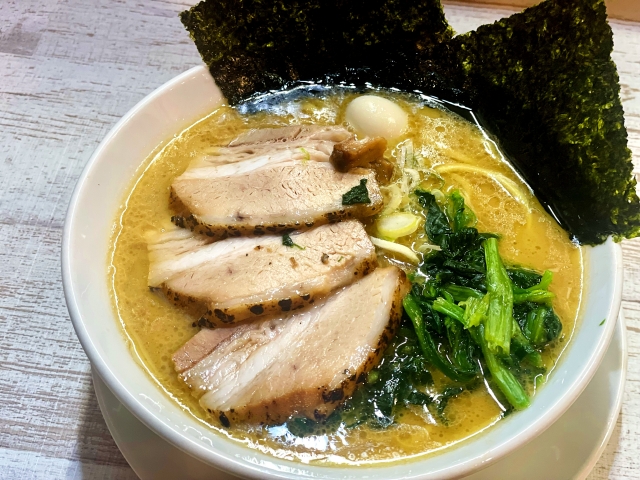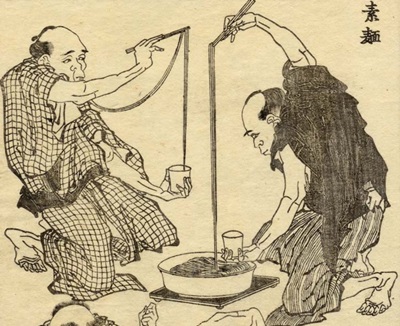Why is ramen so ridiculously irresistible? It’s the kind of flavor that hits you like a bolt of lightning, shaking your senses to the core. You’re left in a blissful daze, savoring the lingering taste—and soon enough, you find yourself craving it all over again.
The best part? Whether you’re slurping it up at your local ramen joint or enjoying it from the comfort of your couch thanks to online ordering, ramen’s deliciousness is always within reach.

The iconic taste of Ichiran ramen lies in its creamy tonkotsu broth, perfectly cooked noodles, and famous red spicy sauce.
Ramen has become a beloved dish around the world. Did you know that New York City is home to three locations of Ichiran Ramen, the iconic Japanese Hakata tonkotsu ramen shop?View Map
With its comforting broth, delicious noodles, and your preferred customization options, it’s enjoyable for those who love classic flavors and those who prefer something a bit different. Let’s explore the secrets behind its deliciousness and trace its roots to find the perfect bowl for you—no chopsticks required!
- The Four Essential Flavors
- Styles and Variations of Ramen
- The Evolution and Future of Ramen
- Enjoy Authentic Ramen at Home—No Restaurant Needed!
- Why Ramen Has Taken the World by Storm
- Customizable and Fun
- The Inside Scoop on Ramen Serving Temperatures
- The Origins and History of Ramen
- Differences Between Ramen and Chinese Noodles
- Udon and Soba Culture
- A Smarter Way to Bring Home Items You Can Only Buy in Japan
- Traveler’s Tip: Use Amazon for a More Comfortable Trip
- Important Points to Remember
- A Natural Evolution
- The World of Ramen Awaits
The Four Essential Flavors
Tonkotsu Ramen

It’s Creamy tonkotsu broth, perfectly cooked noodles, and red spicy sauce.
Tonkotsu ramen, which originated in Kyushu, particularly in Hakata, is known for its creamy and rich broth made by simmering pork bones for hours. The result is a thick, milky soup that’s packed with flavor. Paired with thin, straight noodles, tonkotsu ramen is a favorite for those who love bold, intense flavors.
Shoyu Ramen

a flavorful soy sauce broth, tender pork slices, and fresh toppings.
This soy sauce-based ramen is one of the classic styles in Japan. The broth is clear and rich, offering a well-balanced flavor that’s deeply satisfying.
Shio Ramen

Refreshing shio ramen. A a delicate and clear broth with tender pork, soft-boiled egg, and a green and red onions. A subtle yet satisfying flavor from Japan.
Known for its light and delicate taste, shio ramen is made with a Dashi-based broth. It’s often clear and made with chicken or seafood, allowing the natural flavors of the ingredients to shine through.
Miso Ramen

Hearty miso ramen | a flavorful miso-based broth with sweet corn, creamy butter, and tender pork. A comforting bowl full of robust flavors from Japan.
Miso-based ramen is particularly famous in Sapporo, Hokkaido. It’s hearty and rich, with a thick, comforting broth that’s perfect for cold weather.
Styles and Variations of Ramen
Iekei Ramen

The defining feature of Iekei ramen is its tonkotsu soy sauce-based broth, topped with chicken oil (chiyu) for a rich and aromatic finish. The toppings typically include chashu pork, green onions, spinach, and seaweed.
Japanese ramen culture goes beyond these basic flavors, encompassing a wide range of styles and variations. For example, Iekei Ramen (originating in Yokohama) is known for its thick, straight noodles served in a rich pork and soy sauce broth.
Jiro-style ramen

Jiro-style ramen is known for its massive portions, with a large serving of bean sprouts and chashu pork. The broth is usually a simple tonkotsu soy sauce, and you can add toppings like green onions and garlic. The thick, firm noodles are also a key feature.”
There’s also Jiro-style ramen, famous for its large portions and robust flavors.
Sapporo Ramen

a flavorful miso-based broth with sweet corn, creamy butter, and tender pork. A comforting bowl full of robust flavors from Japan.
Miso ramen features a rich miso broth with hearty toppings like butter, making it perfect for Hokkaido’s cold climate.
Hakata Tonkotsu Ramen

Authentic Hakata tonkotsu ramen | rich and creamy pork bone broth, thin noodles, and savory chashu pork. A classic taste from Fukuoka, Japan
On the other hand, Hakata Ramen from Fukuoka is known for its tonkotsu broth and thin, straight noodles. These regional specialties offer a unique taste experience and are a must-try for any ramen enthusiast traveling through Japan.
The Evolution and Future of Ramen

Refreshing vegan ramen: a light and flavorful broth, garnished with grilled tomato, fresh greens, and vibrant purple sprouts. A delicious plant-based alternative.
Japanese ramen has continually evolved over the years. Recently, new styles such as vegan ramen and fusion ramen influenced by international cuisines have emerged, reflecting the ever-changing culinary landscape.
Enjoy Authentic Ramen at Home—No Restaurant Needed!

Craving ramen but don’t have a shop nearby? No problem. You can enjoy authentic Japanese ramen right at home.
With just a few clicks on Amazon, the best Tonkotsu, Shoyu, Miso, and Shio ramen—handpicked by me, someone who’s tasted a wide variety of Japanese ramen—will be delivered straight to your door. Whether you’re into classic flavors or something new, there’s a perfect bowl waiting for you.
Tonkotsu-style Ramen (豚骨系ラーメン)
Tonkotsu ramen features a rich, creamy broth made by simmering pork bones. It’s known for its deep flavor and thick, white soup, often paired with thin noodles .
amazon | Iciran Fine Straight Noodles Tonkotsu Soup
Shoyu-style Ramen (醤油系ラーメン)
Shoyu ramen is made with a soy sauce-based broth. The clear, brown soup has a savory taste, usually served with wavy noodles.
amazon | Chiken Broth Shoyu Ramen
Miso-style Ramen (味噌系ラーメン)
Miso ramen uses a broth made from fermented soybean paste, giving it a thick, robust flavor. It’s often served with curly noodles.
Shio-style Ramen (塩系ラーメン)
Shio ramen features a light, clear broth seasoned with salt. It has a delicate flavor and is usually paired with thin noodles.
Why Ramen Has Taken the World by Storm
Ramen’s global popularity can be attributed to several factors. It’s Convenient and Delicious: Ramen is a quick, easy meal that can be enjoyed by anyone, anywhere. The introduction of instant ramen further propelled its popularity, making it accessible to people around the world.
Customizable and Fun

One of the best things about ramen is its versatility. You can tailor it to your taste, adding your favorite toppings, adjusting the broth’s richness, or choosing a noodle style that suits you. This adaptability has made it a hit in different cultures, where people can enjoy it in their own way.
The Inside Scoop on Ramen Serving Temperatures

One of the more interesting cultural differences is the temperature at which ramen is served. In Japan, ramen is typically served piping hot, and it’s perfectly normal to slurp those noodles as you eat. In fact, slurping is not considered bad manners at all—it’s just a part of everyday life in Japan. Slurping not only enhances the aroma of the broth but also helps cool down those steaming noodles as you eat. This could be seen as a testament to Japan’s long history of noodle culture.

Whenever I order ramen at a restaurant in Canada, I always add, “And please bring it out piping hot!”
However, in many other countries, slurping is often seen as impolite, so ramen is usually served a bit cooler. If you ever find yourself eating ramen in Japan, don’t be surprised by the heat! And if you’re a “cat tongue” (someone who’s sensitive to hot foods), be careful! Of course, whether you choose to slurp or not is entirely up to you.
The Origins and History of Ramen

The origins of Japanese ramen can be traced back to Chinese noodle dishes. In the late 19th and early 20th centuries, particularly during the Meiji era, Chinese immigrants and workers brought their cuisine to Japan, laying the foundation for what would become ramen. During this time, these Chinese noodles were integrated into Japanese food culture and gradually evolved into something uniquely Japanese.
Differences Between Ramen and Chinese Noodles
While Japanese ramen originated from Chinese noodle dishes, it has undergone significant changes over time to become distinctly Japanese. The broth, noodle types, and toppings have all been adapted to suit Japanese tastes, resulting in the ramen we know today. Because of these changes, modern Japanese ramen is quite different from its Chinese counterparts.
Udon and Soba Culture

Long before ramen became popular in Japan, the country already had a well-established culture of eating udon and soba. These noodle dishes have been enjoyed for centuries, with a history that spans over 450 years.
A Smarter Way to Bring Home Items You Can Only Buy in Japan

During your travels in Japan, you will discover special items that are full of the country’s unique charm. For example, there are limited-edition anime figures, local goods found only at their “sacred sites,” exquisite items of traditional craftsmanship, and delicious, uniquely Japanese foods prepared with time and care.
It’s only natural to want to bring a taste of its culture and flavors home with you, whether as the perfect gift for your loved ones, or a special memento for yourself.
However, there is always one challenge: your luggage.
-
“I found the perfect souvenir at a place I visited, but I hesitate because it’s difficult to carry it around all day while sightseeing.”
“I’d love to collect specialties from all over Japan, but considering the travel time and expense, it’s just not feasible. If only I could have everything delivered to my hotel…?”
It’s a shame to give up on these great finds for such reasons.
But there is a solution that many travelers to Japan are already using:
It’s a method of ordering items from online shops like Amazon and arranging for direct delivery to your hotel.
Traveler’s Tip: Use Amazon for a More Comfortable Trip

This method offers significant advantages for any traveler.
- Sightsee Hands-Free: Enjoy your day to the fullest without being weighed down by heavy shopping bags.
- Use your existing Amazon account or create a new one.
- Clear Delivery Dates: You can check the estimated delivery date when you order, allowing you to coordinate with your stay.
- Ship Directly to Your Hotel: Simply add your hotel as a new shipping address. This makes packing for your return flight incredibly easy.
- Unbeatable Selection: From local crafts and foods to everyday necessities, you can find an endless array of products from all over Japan.
Important Points to Remember
- Check the Estimated Arrival Date: When ordering, always confirm the “estimated delivery date.” Only use this method if you have plenty of time to receive the package during your stay.
- Confirm with Your Hotel First: Before you order, it is essential to ask your hotel if they are willing to accept packages for guests. Most major hotels are happy to do so, but confirming in advance is a mandatory courtesy.
- At Your Own Discretion: Please remember that arranging this is your own responsibility and is done at your own risk.

Order on Amazon, deliver to your accommodation. It’s the simple travel hack for a comfortable, luggage-free journey.
A Natural Evolution

Japan has long had its own unique noodle culture, so it was only natural that ramen would develop and thrive in this environment. As a result, ramen has secured its place alongside other traditional Japanese noodle dishes as a staple of Japanese cuisine.
The World of Ramen Awaits
Ramen—it’s like a lightning bolt of flavor that instantly sweeps you off your feet, a pure umami bomb in a bowl. Whether you’re savoring a bowl in Japan or indulging abroad, take a moment to appreciate the broth, where all those wonderful ingredients have melted together into a symphony of taste.
And when that steaming bowl of ramen lands in front of you, embrace the heat, take a big slurp, and become one with the ramen.
Who knows? You might just discover a whole new world. So, let’s slurp together and dive into the deliciousness!
In our next article, We’ll bring you more delicious topics in our next article. Stay tuned! Don’t miss it.




